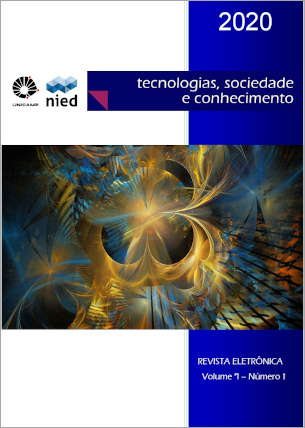Resumo
Este trabalho é um estudo exploratório que se apoia em três pilares na busca por um melhor ensino de programação: a robótica educativa, a abordagem construcionista e a Taxonomia de Bloom revisada, com o intuito de identificar métodos e estratégias para o crescimento da qualidade do ensino de programação introdutória. Para isso, duas aplicações foram realizadas com alunos de ensino médio em escolas públicas do Rio de Janeiro, e seus resultados analisados e comparados com uma disciplina de programação oferecida por uma universidade federal local. Espera-se, com esse estudo, a possibilidade de construir novas propostas e identificar caminhos para o fomento da educação em ciência, tecnologia, engenharia e matemática em escolas públicas brasileiras
Referências
ACKERMAN, E. (2001). Piaget’s constructivism, Papert’s constructionism: What’s the difference?. Future of learning group publication, v. 5, n. 3, p. 438.
ALVES, R. M. DuinoBlocks: Desenho e implementação de um ambiente de programação visual para robótica educacional. 2013. Dissertação (Mestrado em Informática), Programa de Pós-Graduação em Informática, Universidade Federal do Rio de Janeiro, Rio de Janeiro, 2013.
ANDERSON, L. W.; KRATHWOHL, D. R.; AIRASIAN, P. W.; CRUIKSHANK, K. A.; MAYER, R. E.; PINTRICH, P.; RATHS, J.; WITTROCK, M. C. A taxonomy for learning, teaching, and assessing: A revision of Bloom’s Taxonomy of Educational Objectives. New York: Longman, 2001.
BARKER, B. S.; ANSORGE J. Robotics as a means to increase achievement scores in an informal learning environment. Journal of Research on Technology in Education, v. 39, n. 3, p. 229–243, 2007.
BARNES, D. J. Teaching Introductory Java through LEGO MINDSTORMS models. In: TECHNICAL SYMPOSIUM ON COMPUTER SCIENCE EDUCATION. - 33rd.SIGCSE. 2002. Cincinnati, EUA. Proceedings... Nova York, ACM, 2002, p. 147–151.
BEER, R.; CHIEL, H.; DRUSHEL, R. Autonomous Robotics to Teach Science and Engineering. Communications of The ACM, v. 42, no. 6, p. 85-92. 1999
CHIOU, A. Teaching Technology Using Educational Robotics. In: AUSTRALIAN CONFERENCE ON SCIENCE AND MATHEMATICS EDUCATION. ACSME, 2004, Sidney, Australia. Proceedings… University of Sydney, 2004. p. 9-14.
COHEN, L; MANION, L; MORRISON, K. Research Methods in Education. New York: Taylor & Francis, 2013.
DARGAINS, A. R. Estudo exploratório sobre o uso da robótica educacional no ensino de programação introdutória. 2015. Dissertação (Mestrado em Informática), Programa de Pós-Graduação em Informática, Universidade Federal do Rio de Janeiro, Rio de Janeiro. 2015.
de JESUS, E.; RAABE, A. Interpretações da Taxonomia de Bloom no Contexto da Programação Introdutória. In: SIMPÓSIO BRASILEIRO DE INFORMÁTICA NA EDUCAÇÃO, 20o SBIE, 2009. Florianópolis. Universidade Federal de Santa Catarina. Anais... UFSC, Florianopolis, 2009. p. 1–10.
DiSESSA, A. Changing Minds: Computers, Learning, and Literacy. Cambridge: MIT Press. 2000.
EGUCHI, A. RoboCupJunior for promoting STEM education, 21st century skills, and technological advancement through robotics competition”. Robotics and Autonomous System, v. 75, p. 692-699, 2016.
FAGIN, B.; MERKLE, L. Measuring the Effectiveness of Robots in Teaching Computer Science." ACM SIGCSE Bulletin, v. 35, n. 1, 2003.
FLANNERY, L.; SILVERMAN, B.; KAZAKOFF, E.; BERS, M.; BONTÁ P.; RESNICK M. Designing Scratchjr. Support for early childhood learning through computer programming. In: INTERNATIONAL CONFERENCE ON INTERACTION DESIGN AND CHILDREN. Nova York, EUA. Proceedings... Nova York, ACM, 2013, pp. 1–10.
GOH, H.; ARIS, B. Using robotics in education: lessons learned and learning experiences. Smart Teaching & Learning: Re-engineering ID, Utilization and Innovation of Technology. In: 1st. INTERNATIONAL MALAYSIAN EDUCATIONAL TECHNOLOGY CONVENTION, 2007, Johor Bhur, Malasia. Proceedings... Faculty of Education University Teknologi Malaysia, 2007, p. 1156–1163.
GROVER, S.; PEA, R. Computational Thinking in K12. A Review of the State of the Field. Educational Researcher, v. 42, n.1, p.38-43, 2013.
JOHNSON, C.; FULLER, U. Is Bloom's taxonomy appropriate for computer science?. In: BALTIC SEA CONFERENCE ON COMPUTING EDUCATION RESEARCH, 2006, Uppsala, Suécia. Proceedings… Uppsala University, Suécia, 2017. p. 120-124.
KAYA, E.; HASAN, D. Thinking Intervention on Preservice Elementary Science Teachers’ Computational Thinking Teaching Efficacy Beliefs, Interest and Confidence. In: CONFERENCE OF THE SOCIETY FOR INFORMATION TECHNOLOGY AND TEACHER EDUCATION, SITE 2019, Las Vegas, EUA. Proceedings... Waynesville, Carolina do Norte, EUA, AACE, 2019, p. 1600–1605.
KELLEHER, C.; PAUSCH, R. Lowering the Barriers to Programming: A survey of programming environments and languages for novice programmers. ACM Computing Surveys, v. 37, n. 2, p 83–137, 2005.
KRATHWOHL, D.; BLOOM, B.; MASIA, B. Taxonomy of educational objectives: the classification of educational goals. Handbook Volume 2: Affective domain. 1964
LEPUSCHITZ, W.; MERDAN, M.; KOPPENSTEINER, M.; BALOGH, G.; OBDRZALEK, D. (Eds.). Robotics in Education - Latest Results and Developments. 2017.
MAJOR, L.; KYRIACOU, T.; BRERENTON, O. P. Systematic Literature Review: Teaching Novices Programming Using Robots. In: EVALUATION AND ASSESSMENT IN SOFTWARE ENGINEERING ANNUAL CONFERENCE, 2011, Durham (UK). Proceedings... Londres, Institution of Engineering and Technology, 2011, p. 502-513.
MARTINEZ, L. G.; MARRUFO, S.; LICEA, G.; REYNEZ-JUAREZ, J.; AGUILAR, L. Using a Mobile Platform for Teaching and Learning Object Oriented Programming. IEEE Latin America Transactions, v. 16, n.6, 2018.
MAUCH, E. Using technological innovation to improve the problem solving skills of middle school students. The Clearing House. v.75, n. 4, p. 211–213, 2001.
McCRACKEN, M.; ALMSTRUM, M. V.; DIAZ, D.; GUZDIAL, M.; HAGAN, D.; KOLIKANT, Y. B. D.; LAXER, C.; THOMAS, L.; UTTING, I.; WILUSZ, T. A multi-national, multi-institutional study of assessment of programming skills of first-year CS students. ACM SIGCSE Bulletin, v. 33, n.4, p. 125-140, 2001.
NOURBAKHSH, I.; CROWLEY, K.; BHAVE, A.; HAMNER, E.; HSIU, T.; PEREZ-BERGGUIST, A.; RICHARDS, S.; WILKINSON, K. The Robotic Autonomy Mobile Robotics Course: Robot Design, Curriculum Design and Educational Assessment. Autonomous Robots, v. 18, n.1, p. 103-27, 2005.
PAPERT, S. Mindstorms: Children, Computers and Powerful Ideas. 1980.
PAPERT, S. Situating Constructionism. In: PAPERT, S.; HAREL, I. (Eds.), Constructionism. p. 1-11. 1991.
PAPERT, S. A máquina das crianças: repensando a escola na era da informática. Porto Alegre: Artmed. 1994.

Este trabalho está licenciado sob uma licença Creative Commons Attribution 4.0 International License.
Copyright (c) 2020 André Rachman Dargains, Fábio Ferrentini Sampaio


